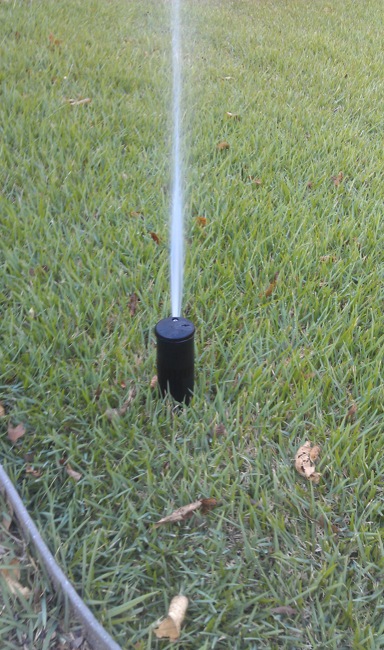
TIME OF DAY:
Don’t water during daylight hours; you could lose as much as 50% to evaporation due to heat and wind. Don’t water too early in the evening (6pm-10pm); your yard stays wet all night and it encourages diseases and fungus.
Do water in the early morning hours (1am-8am) to optimize efficiency while reducing disease.
FREQUENCY:
Generally speaking it is beneficial for both turf and shrubs/trees to water LESS frequently for LONGER durations. This accomplishes 3 things:
1. It encourages root growth by training the plant to actively seek water.
2. It discourages fungus and diseases by allowing the landscape to dry out between waterings.
3. It reduces soil salinity by washing away excess salt accumulation.
In an ideal world you would only water one time per week. However, many of our soils here in the Brazos Valley have high clay content which means there is a practical limit to the duration that you can effectively water because the soil can only absorb a finite amount of water. After the clay soil becomes saturated additional water will cause “run-off” which is wasted water. We’ve found over the years that watering 2-3 times per week is a good way to balance the clay in our soils with the warm climate. Here’s an example seasonal watering schedule:
March – June water two times per week
June – August water three times per week
September – November water two times per week
November – February water zero or one time per week
DURATION:
There are (3) basic types of sprinkler emitters:
- fixed-spray sprinkler
- gear-driven rotating sprinkler
- landscape drip tubing
Each of these emitting devices have different application rates and therefore should never be set to water for equal lengths of time. Sprinkler emitting devices are measured in “precipitation rate”, which is the equivalent rainfall over a duration of time. Here are the approximate typical precipitation rates for the basic types of emitting devices:
fixed-spray sprinklers: 1.5 inches per hour
gear-driven rotating sprinkler: 0.5 inches per hour
landscape drip tubing: 0.4 inches per hour
(Each installation is different and other factors contribute to precipitation rate.)
When you’re trying to determine how many minutes to water each area of your irrigation system you need to know what type of sprinklers are in each area and you need to know the current “evapotranspiration rate”. Evapotranspiration is the combination of water evaporation from the soil and water transpiration through the leaves of your plants. It is a complicated formula that takes into account temperature and wind speeds. Fortunately you don’t need to know how to calculate ET because there are web resources that can help you determine the ET for your area. Here’s a link to one of them, the Texas ET Network: http://texaset.tamu.edu/
As an example let’s say the ET for a week in June is 1.5″. That means in order to have a healthy lawn and landscape you need to REPLACE the water lost to evapotranspiration with water from your irrigation system. That means you would need to water your irrigation system for the following number of minutes for that week:
60 minutes for the fixed spray heads (1.5 inches divided by 1.5 inches per hour equals one hour)
180 minutes for the gear-driven rotors (1.5 inches divided by 0.5 inches per hour equals 3 hours)
225 minutes for the landscape drip tubing (1.5 inches divided by .4 inches per hour equals 3 hours and 45 minutes)
Remember that we’re talking about ONE WEEK of ET, so we can break up the waterings into two or three watering days. So if you watered two times in a week you would water the spray heads for 30 minutes, the rotors for 90 minutes and the drip for 112 minutes. If you wanted to water three times in a week you would water the spray heads for 20 minutes, the rotors for 60 minutes and the drip for 75 minutes.
